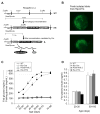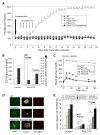Secondary consequences of beta cell inexcitability: identification and prevention in a murine model of K(ATP)-induced neonatal diabetes mellitus
- PMID: 19187772
- PMCID: PMC4793729
- DOI: 10.1016/j.cmet.2008.12.005
Secondary consequences of beta cell inexcitability: identification and prevention in a murine model of K(ATP)-induced neonatal diabetes mellitus
Abstract
ATP-insensitive K(ATP) channel mutations cause neonatal diabetes mellitus (NDM). To explore the mechanistic etiology, we generated transgenic mice carrying an ATP-insensitive mutant K(ATP) channel subunit. Constitutive expression in pancreatic beta cells caused neonatal hyperglycemia and progression to severe diabetes and growth retardation, with loss of islet insulin content and beta cell architecture. Tamoxifen-induced expression in adult beta cells led to diabetes within 2 weeks, with similar secondary consequences. Diabetes was prevented by transplantation of normal islets under the kidney capsule. Moreover, the endogenous islets maintained normal insulin content and secretion in response to sulfonylureas, but not glucose, consistent with reduced ATP sensitivity of beta cell K(ATP) channels. In NDM, transfer to sulfonylurea therapy is less effective in older patients. This may stem from poor glycemic control or lack of insulin because glibenclamide treatment prior to tamoxifen induction prevented diabetes and secondary complications in mice but failed to halt disease progression after diabetes had developed.
Figures







Similar articles
-
Acute sulfonylurea therapy at disease onset can cause permanent remission of KATP-induced diabetes.Diabetes. 2011 Oct;60(10):2515-22. doi: 10.2337/db11-0538. Epub 2011 Aug 3. Diabetes. 2011. PMID: 21813803 Free PMC article.
-
Chronic antidiabetic sulfonylureas in vivo: reversible effects on mouse pancreatic beta-cells.PLoS Med. 2008 Oct 28;5(10):e206. doi: 10.1371/journal.pmed.0050206. PLoS Med. 2008. PMID: 18959471 Free PMC article.
-
Defects in beta cell Ca²+ signalling, glucose metabolism and insulin secretion in a murine model of K(ATP) channel-induced neonatal diabetes mellitus.Diabetologia. 2011 May;54(5):1087-97. doi: 10.1007/s00125-010-2039-7. Epub 2011 Jan 27. Diabetologia. 2011. PMID: 21271337 Free PMC article.
-
The K(ATP) channel and neonatal diabetes.Endocr J. 2009;56(2):165-75. doi: 10.1507/endocrj.k08e-160. Epub 2008 Jun 20. Endocr J. 2009. PMID: 18566517 Review.
-
Diverse roles of K(ATP) channels learned from Kir6.2 genetically engineered mice.Diabetes. 2000 Mar;49(3):311-8. doi: 10.2337/diabetes.49.3.311. Diabetes. 2000. PMID: 10868950 Review.
Cited by
-
Promoter DNA methylation regulates murine SUR1 (Abcc8) and SUR2 (Abcc9) expression in HL-1 cardiomyocytes.PLoS One. 2012;7(7):e41533. doi: 10.1371/journal.pone.0041533. Epub 2012 Jul 23. PLoS One. 2012. PMID: 22844491 Free PMC article.
-
A family of orthologous proteins from centipede venoms inhibit the hKir6.2 channel.Sci Rep. 2019 Oct 1;9(1):14088. doi: 10.1038/s41598-019-50688-x. Sci Rep. 2019. PMID: 31575961 Free PMC article.
-
ATP and sulfonylurea linkage in the K(ATP) channel solves a diabetes puzzler.Diabetes. 2013 Nov;62(11):3666-8. doi: 10.2337/db13-1194. Diabetes. 2013. PMID: 24158995 Free PMC article. No abstract available.
-
Phase transitions in the multi-cellular regulatory behavior of pancreatic islet excitability.PLoS Comput Biol. 2014 Sep 4;10(9):e1003819. doi: 10.1371/journal.pcbi.1003819. eCollection 2014 Sep. PLoS Comput Biol. 2014. PMID: 25188228 Free PMC article.
-
PDX1LOW MAFALOW β-cells contribute to islet function and insulin release.Nat Commun. 2021 Jan 29;12(1):674. doi: 10.1038/s41467-020-20632-z. Nat Commun. 2021. PMID: 33514698 Free PMC article.
References
-
- Ashcroft FM, Gribble FM. ATP-sensitive K+ channels and insulin secretion: their role in health and disease.[comment] Diabetologia. 1999;42:903–919. - PubMed
-
- Bansal P, Wang Q. Insulin as a physiological modulator of glucagon secretion. Am J Physiol Endocrinol Metab. 2008;295:E751–761. - PubMed
-
- Del Prato S, Marchetti P. Beta- and alpha-cell dysfunction in type 2 diabetes. Horm Metab Res. 2004;36:775–781. - PubMed
-
- Gloyn AL, Cummings EA, Edghill EL, Harries LW, Scott R, Costa T, Temple IK, Hattersley AT, Ellard S. Permanent neonatal diabetes due to paternal germline mosaicism for an activating mutation of the KCNJ11 Gene encoding the Kir6.2 subunit of the beta-cell potassium adenosine triphosphate channel. Journal of Clinical Endocrinology & Metabolism. 2004a;89:3932–3935. - PubMed
Publication types
MeSH terms
Substances
Grants and funding
LinkOut - more resources
Full Text Sources
Molecular Biology Databases

